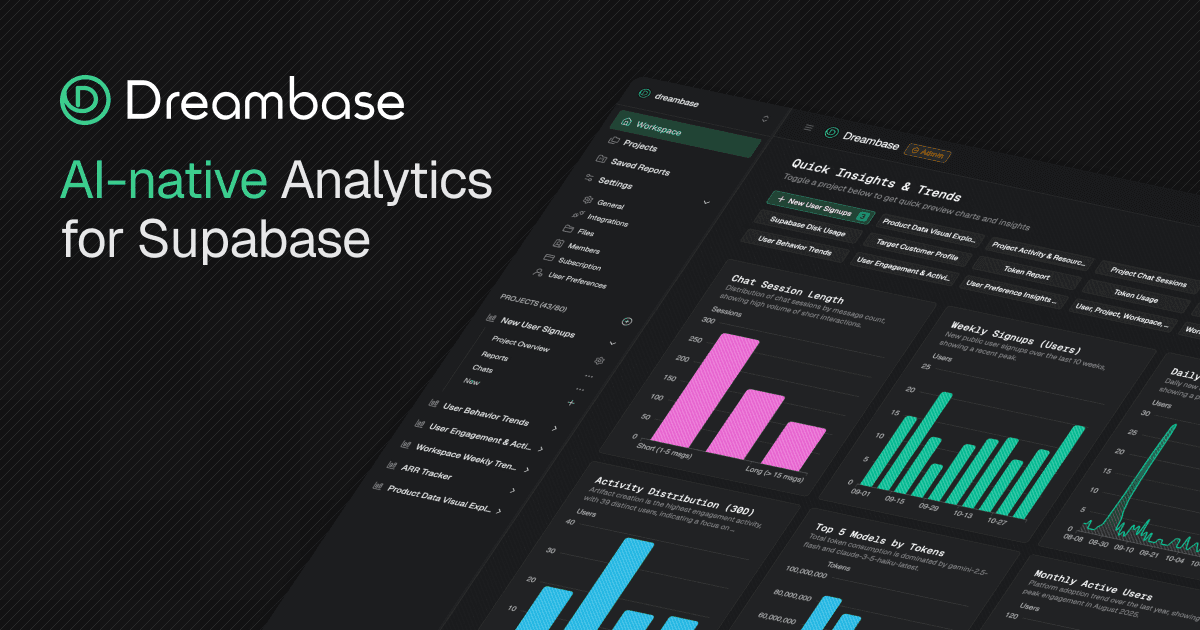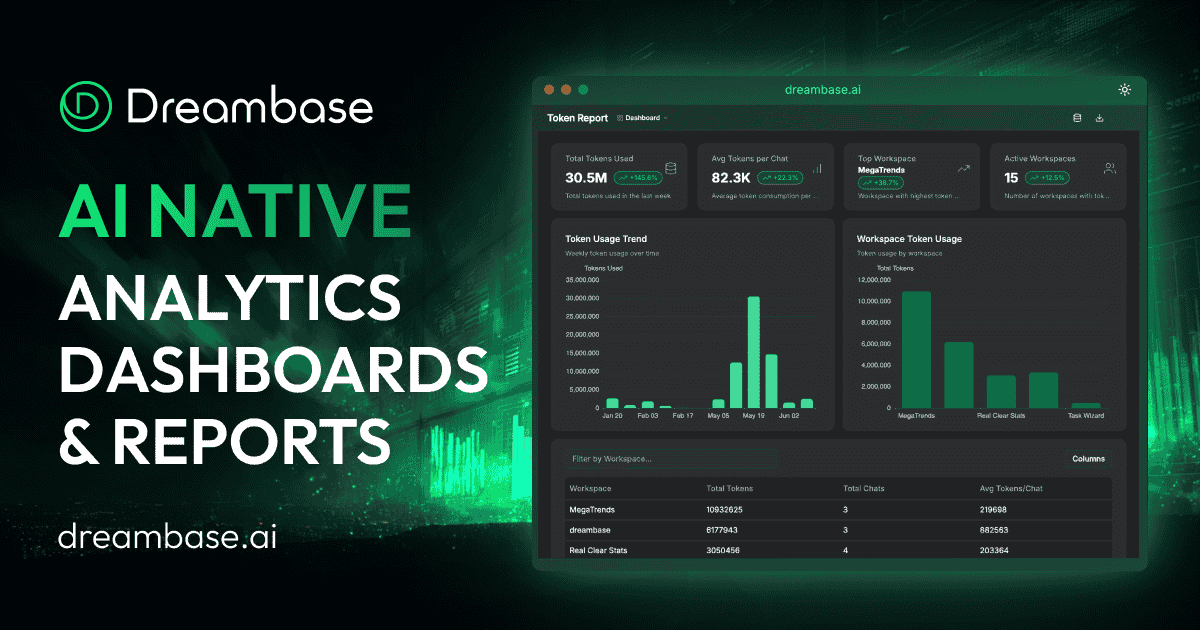
Table of Contents
Overview
For developers and teams leveraging Supabase, accessing comprehensive analytics from database information often requires additional tools, complex configurations, or custom development work. Dreambase is a specialized AI-powered analytics platform designed to integrate directly with Supabase infrastructure, providing native analytics capabilities within the ecosystem. This platform eliminates the need for third-party analytics libraries and extensive setup processes, enabling users to create detailed product reports and dashboards from Supabase data efficiently, with a free tier available for initial exploration.
Key Features
Dreambase is purpose-built for the Supabase ecosystem, offering targeted features that address specific analytics needs within this environment.
- Native Supabase Integration: Connects directly to existing Supabase projects through secure OAuth2 authentication, providing immediate access to database information without complex configuration requirements.
- Rapid Analytics Generation: Creates comprehensive insights and visual dashboards from database queries efficiently, supporting faster decision-making processes for development teams.
- Zero External Dependencies: Operates without requiring additional third-party analytics libraries, maintaining a streamlined technology stack for Supabase users.
- Accessible Entry Point: Offers a free tier that allows users to explore core functionality and generate initial reports without upfront investment.
- Database-to-Report Workflow: Transforms raw database information into structured, actionable reports through automated processes designed for developer productivity.
How It Works
Dreambase follows a straightforward integration process optimized for Supabase users. The workflow begins with establishing a secure connection to your Supabase database through the platform’s native integration system. Users can then execute queries directly using both visual interfaces and SQL capabilities, accessing specific data segments required for their analytical needs. The platform subsequently generates comprehensive reports and dashboards from these queries, converting database results into clear, interactive visualizations that support data-driven decision making throughout the development lifecycle.
Use Cases
Dreambase addresses specific analytical scenarios within the Supabase development ecosystem where integrated insights prove essential.
- Supabase Product Analytics: Extract detailed insights into user behavior patterns, feature utilization metrics, and application performance data directly from Supabase backend systems, enabling informed product development decisions.
- Rapid Dashboard Development: Build and iterate on essential monitoring dashboards for key performance indicators, user engagement tracking, and system health metrics without requiring extensive frontend development resources.
- No-Code Reporting Solutions: Enable non-technical team members to generate meaningful reports and analyze data trends without SQL programming requirements, fostering broader organizational data literacy.
Pros \& Cons
Advantages
- Cost-Effective Entry: Begin utilizing professional-grade analytics capabilities without initial licensing costs, making it accessible for projects across budget ranges.
- Supabase-Optimized Experience: Benefit from purpose-built integration that leverages Supabase-specific features and maintains consistency with existing project workflows.
- Streamlined Implementation: Achieve operational analytics capabilities within minutes rather than days, allowing development teams to focus on core application development rather than analytics infrastructure.
Disadvantages
- Platform Dependency: Functionality is exclusively available to Supabase users, limiting applicability for projects using alternative backend services or multi-platform architectures.
- Specialized Feature Set: While effective within its domain, may not provide the advanced analytical capabilities found in enterprise-grade business intelligence platforms designed for complex organizational requirements.
How Does It Compare?
When evaluating Dreambase against other analytics solutions, its specialized positioning within the Supabase ecosystem becomes apparent. Basedash offers AI-powered business intelligence with support for 600+ data sources, including comprehensive Supabase integration, making it suitable for teams requiring broader connectivity options. Draxlr, as an official Supabase partner, provides no-code BI capabilities with real-time alert systems and dashboard embedding features specifically tailored for Supabase users.
Metabase delivers open-source business intelligence with AI-assisted query generation and extensive customization options, serving organizations requiring comprehensive self-hosted analytics solutions. Looker Studio provides Google’s free data visualization platform with modern charting capabilities and responsive report layouts, suitable for teams working within Google’s ecosystem.
Dreambase distinguishes itself through its exclusive focus on Supabase integration and AI-powered context generation, offering database-first analytics that maintain direct connections to source data. While established BI platforms provide broader feature sets and multi-platform support, Dreambase targets users seeking specialized Supabase analytics without the complexity of configuring general-purpose tools. The optimal choice depends on project scope, technical requirements, and ecosystem alignment.
Final Thoughts
Dreambase presents a focused analytics solution for development teams building on Supabase infrastructure. Its emphasis on native integration and rapid report generation addresses specific needs within the Supabase ecosystem, particularly for teams seeking to implement analytics capabilities without extensive configuration overhead. While considerations include platform dependency and the availability of alternative specialized tools, its database-first approach and streamlined integration provide value for users prioritizing efficient Supabase-native analytics workflows. The platform’s continued development will likely depend on expanding its AI capabilities and strengthening its position within the growing Supabase partner ecosystem.

